Is It Hard to Read on a 34inch Ultrawide 1080
Writer: Adam Simmons
Concluding updated: February 8th 2022
Looking for specific UltraWide recommendations? Take a look at our reviews and the recommendations section.
Introduction
Every bit we explored in this article, the 21:nine aspect ratio provides a potentially very immersive viewing feel. Using the correct movie software and viewing content mastered in 'UltraWide' aspect ratios (more for major Hollywood blockbusters than TV shows) gives a screen-filling cinematic feel that actually draws y'all in. Most game titles, meanwhile, will offer you an expanded Field of View which really enriches the gaming experience. Despite this, some people feel that the 29" 2560 x 1080 models which that article was based around are too restrictive both in terms of concrete size and resolution – especially vertically.
The AOC u3477Pqu is i of an increasing number of monitors that maintains the 21:9 aspect ratio but offers a screen that is significantly wider and taller than previous offerings. Rather than being the same height as a 23" 16:9 monitor, information technology'south the same height equally a 27" 16:ix monitor. The resolution has also been increased to 3440 x 1440, which provides a pixel density of 109.68 PPI – very shut to a 27" model with 2560 x 1440 resolution. Rather than existence similar a 23" xvi:9 model with extra width and horizontal pixels, this screen is similar a 27" 16:9 model with extra width and horizontal pixels.
On the desktop
The big amount of physical infinite and nice pixel density offered past this screen size and resolution provide smashing potential on the desktop. The prototype below shows how barren that desktop can look without anything going on.
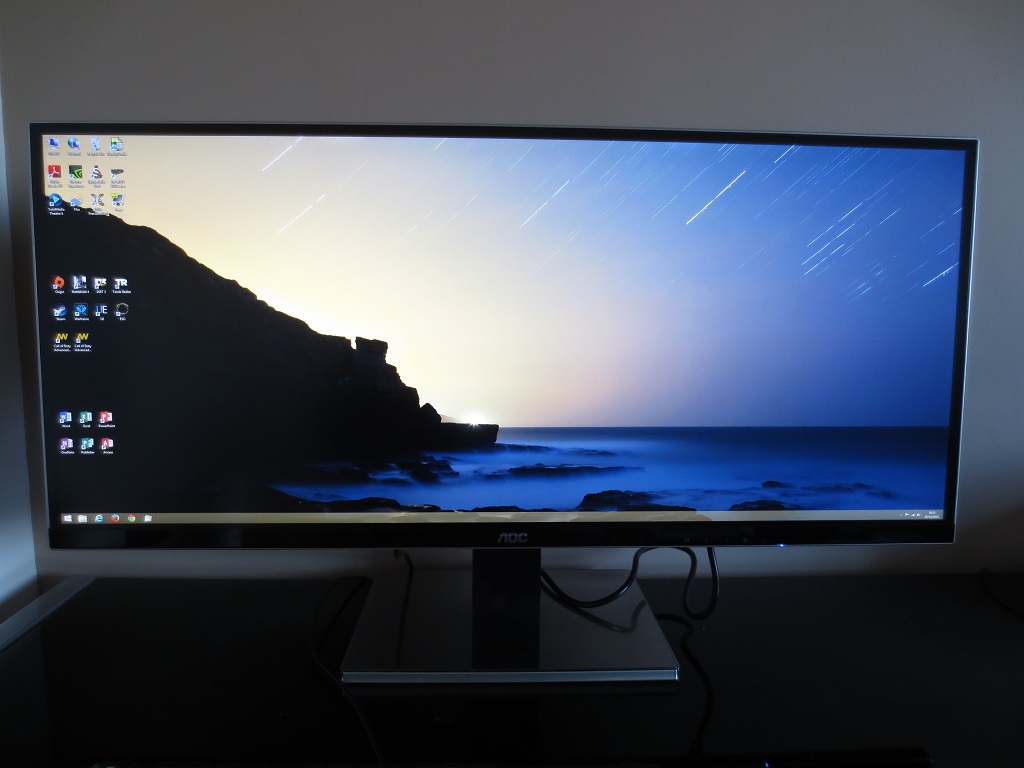
You can also see, if yous take a single browser window open on the internet, that y'all tend to end upward with a lot of empty 'white infinite' going unused. The notable exception to this is some forums which will fill up more of the screen with text. Nigh websites, even so, will look something like in the image below (except often less cute).
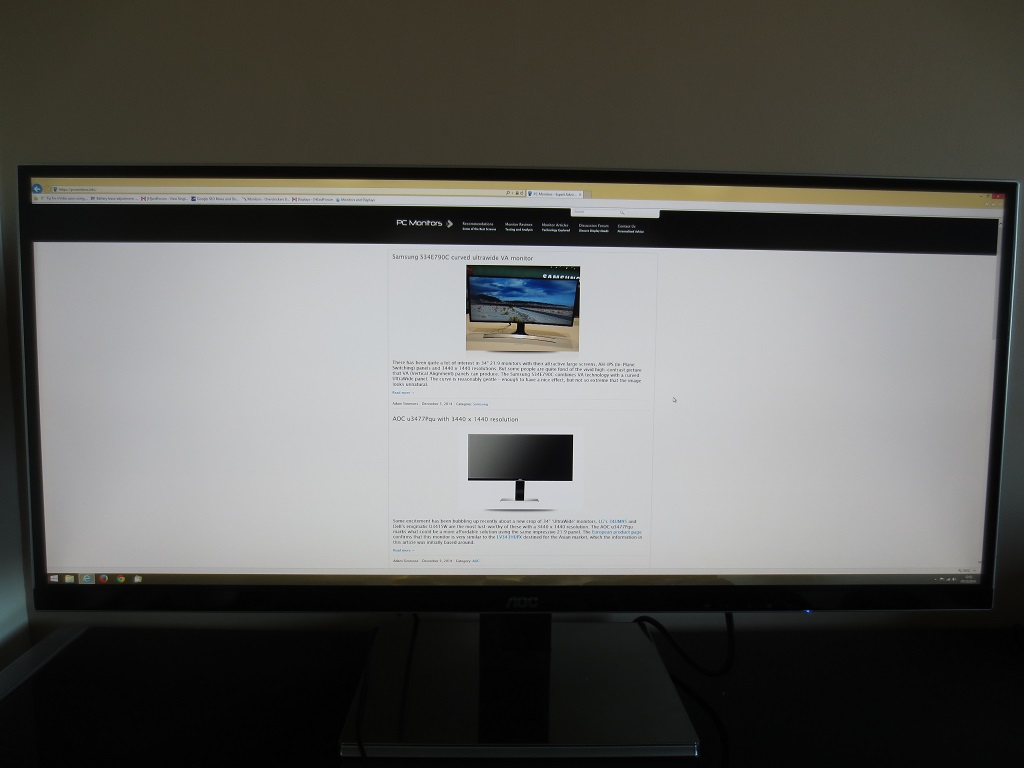
Where the screen actually comes into its ain is for multi-tasking, for example having 2 windows open adjacent. The first image below shows two websites open (on two divide web browsers, only for multifariousness). You can encounter that there is a great amount of usable space on each window – the browser windows don't feel cramped. The 2d paradigm shows a Microsoft Excel spreadsheet and Microsoft Word certificate open side-by-side, again with enough of usable space for each awarding.
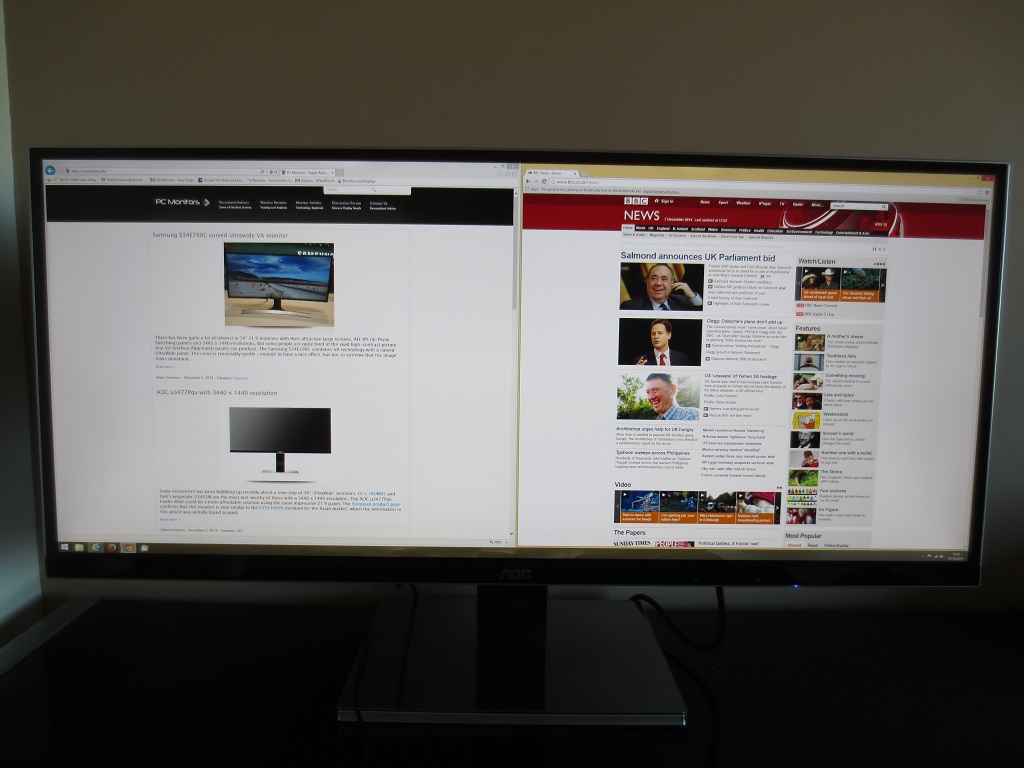

Gaming
When it comes to gaming, the 21:9 attribute ratio offers a 'Field Of View' (FOV) advantage in nearly titles. The majority of games apply Hor+ scaling, which ways that the vertical component of the FOV is fixed whilst the horizontal component increases every bit the attribute ratio widens. Our original article on the 21:9 experience explored the sort of gains y'all can await in FOV over a xvi:9 monitor. Rather than repeating such an assay, we're going to allow the pictures speak for themselves. We tested a range of game titles, including some which are shown in the glorious pictures below.
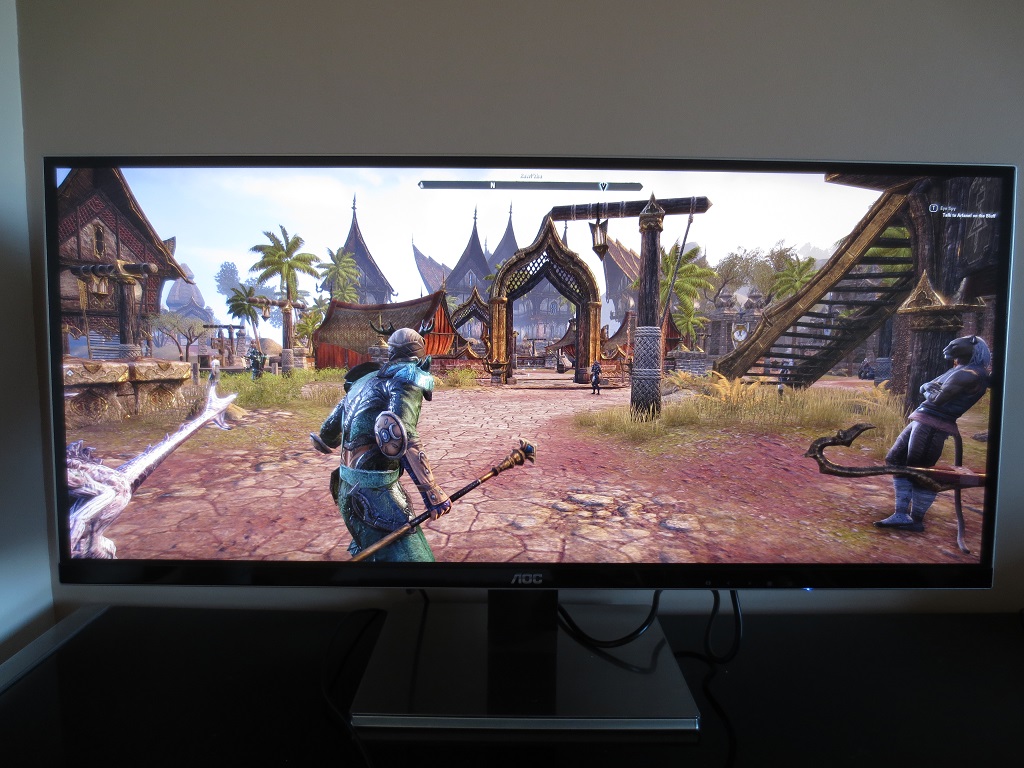




The extra FOV was in itself a very overnice affair when gaming, but when combined with such a large screen it provided an exceptionally engrossing experience similar no other nosotros've experienced. It really drew you into the game earth, engaging not simply your normal visual field but also your peripheral vision. The pixel density was besides pleasing – enough to give elements the sort of nice particular you'd see on a 27" WQHD or xl" UHD monitor whilst requiring a level of GPU horsepower some way between the two. Nosotros won't turn this into a GPU review, but we were only using a single Nvidia GTX 970 on our system and found our game titles ran nicely at fairly loftier detail settings. By nicely we hateful hitting the optimal 60fps for the monitor adequately consistently. We didn't run everything at Ultra and stuck to using 2x MFAA by and large, but the visual experience was nevertheless very rewarding. At times we found ourselves not actually playing the game but rather simply admiring the virtual view.
It's worth noting that support for 21:9 in games is a lot more widespread than people realise, especially on fairly recent titles. We tested the titles mentioned higher up and a few extras including ArmA 3 and Warframe. Some out-of-game menu elements on Warframe appeared slightly stretched and the BF4 conversation window at the end of the round was cut off, just aside from that everything worked but fine. The in-game experience was always 'perfect' from the perspective of 21:nine existence handled correctly. That isn't always the case, of course, and there are some titles that just don't work as they should when in game.
As an Amazon Associate I earn from qualifying purchases made using the below link. Where possible, you'll be redirected to your nearest store. Farther information on supporting our piece of work.
WSGF (Widescreen Gaming Forum) is a very useful resource for working out whether a game supports the UltraWide 21:9 attribute ratio correctly. In that location is a database there which lists tried and tested titles and whether they are known to support the 'Ultra Wide Screen' format correctly or any particular bug in that location may exist. You will likely find some titles that work correctly with the 21:nine attribute ratio, but aren't listed on that website. Elder Scrolls Online (ESO) beingness a prime number example of a championship which wasn't 'certified' as working on that site when we tested information technology but nosotros could confirm works perfectly. Information technology was later added to the website and confirmed equally working every bit intended nether 21:ix. It's a great list for knowing for sure that a game volition work correctly, even if information technology doesn't list every compatible title.
One title that we know doesn't work equally it should is Call of Duty: Advanced Warfare (CoD: AW). That is perhaps to be expected. This is a game that is primarily designed for games consoles, with PC users a mere afterthought. Perhaps more crucially it is based on an engine that hasn't really fundamentally changed for several years and has never correctly supported the aspect ratio. At that place are some obvious alarm signs that things aren't working every bit they should when you lot enter the graphics carte and the resolution is listed every bit '3440×1440 [16:vii]'. That is of course non the correct aspect ratio at all.
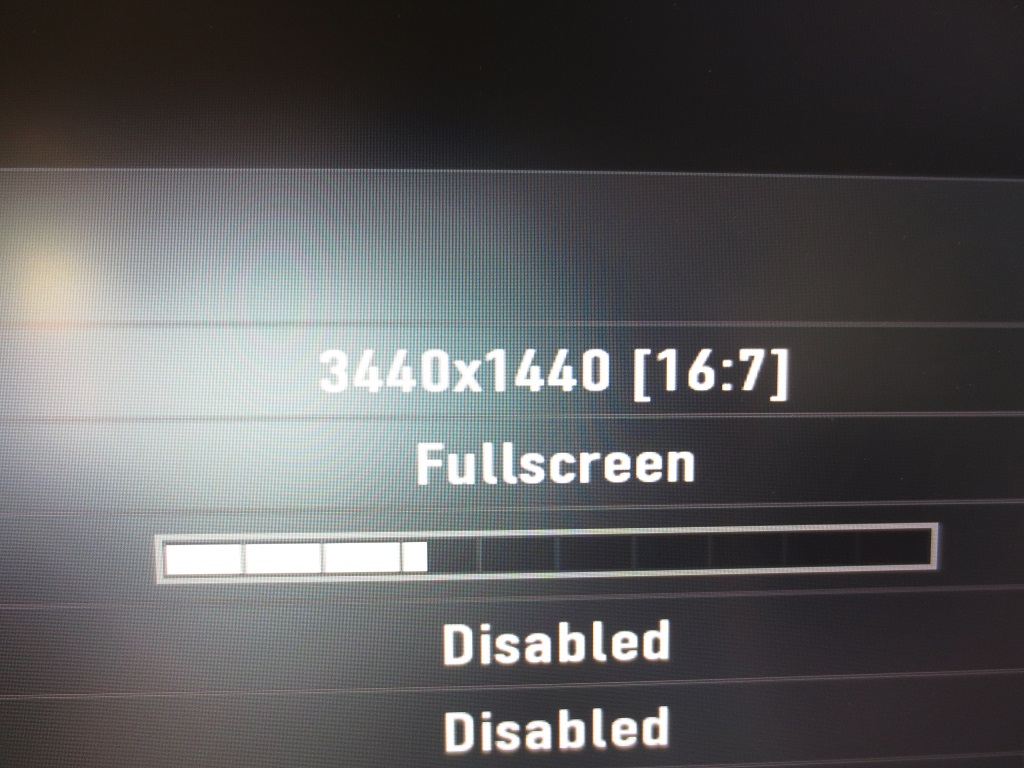
The game itself appears somewhat stretched and you don't proceeds the right Field Of View. This stretching may not be all that obvious in the commencement epitome below, if you're not familiar with the game. Y'all can at least see the FOV is quite restrictive compared to what information technology should exist, if you compare information technology to the before images of games similar Battlefield 4. The 2d image shows how the customisable thespian grapheme model is displayed in this funky 16:seven attribute ratio whilst the third image shows how it should look. This final image was taken at 1920 10 1080 (16:9) on the monitor with 1:1 pixel mapping employed. As you can encounter there is quite a difference and obvious geometric baloney going on.
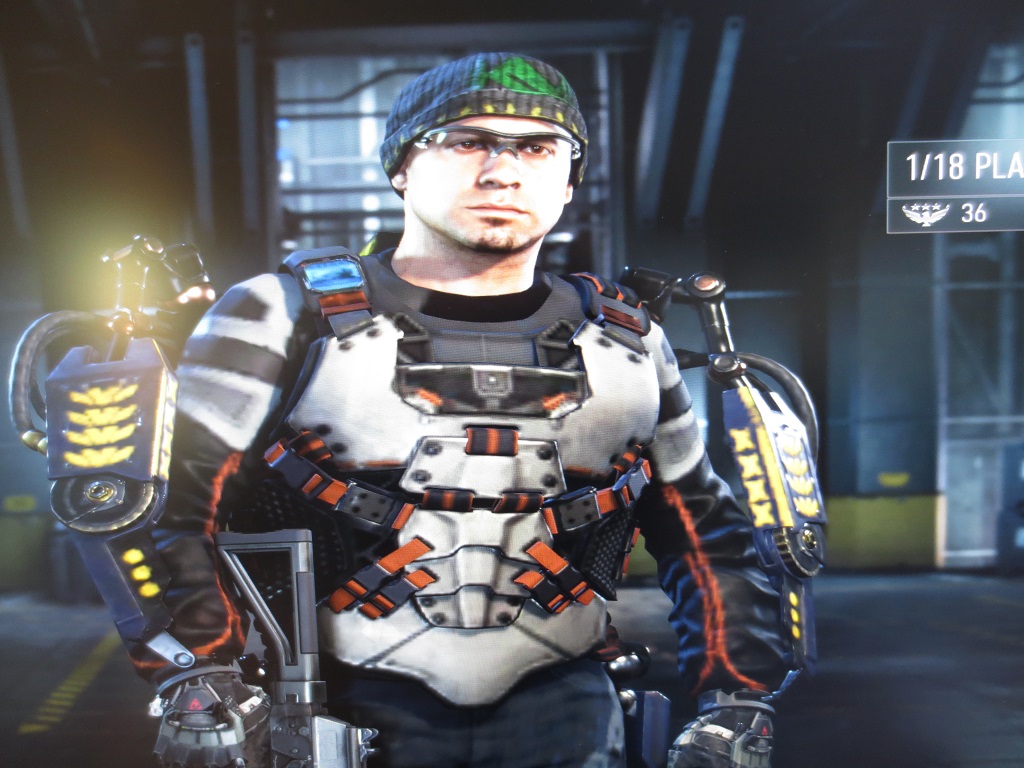

We must again reiterate that the majority of game titles do work correctly in the 21:9 aspect ratio, and the feel that gives on a 34" 3440 x 1440 monitor is truly captivating. For some older titles which don't officially support 21:nine, there is a very useful utility called Flawless Widescreen. This irons out issues on some of these problematic titles so that they work correctly on these UltraWide models and indeed for Eyefinity or Surround setups. This utility hasn't been updated since 2014, so is but designed to correct bug for older titles. Newer COD titles such as Call of Duty: Vanguard piece of work correctly 'out of the box' with the 21:9 aspect ratio and doesn't require such tweaking.
Movie watching
Movies these days are an interesting mixture of attribute ratios. The most common aspect ratios are 16:9 and something that equates to UltraWide – typically betwixt two.35:1 and 2.forty:i. The former is more mutual on content that was originally shown on Television set (Tv set series, for example). Such content fills a sixteen:9 screen without whatsoever sort of black edge only typically has thick black bars either side on a 21:9 monitor or has to be stretched to fit. The images beneath show a 16:9 Blu-Ray (Futurama: Into the Wild Green Yonder) presented with those black confined so stretched to fit on the 21:nine AOC u3477Pqu. Where there are black bars the image itself on a 34" 21:ix monitor is equivalent to viewing on a 27" 16:9 screen – then it isn't like yous're staring at a tiny box or anything. It isn't articulate in the second image, but when it is stretched to fit the prototype becomes noticeably softer – not so bad for an animated picture show like this, but something that can await quite unnatural otherwise.
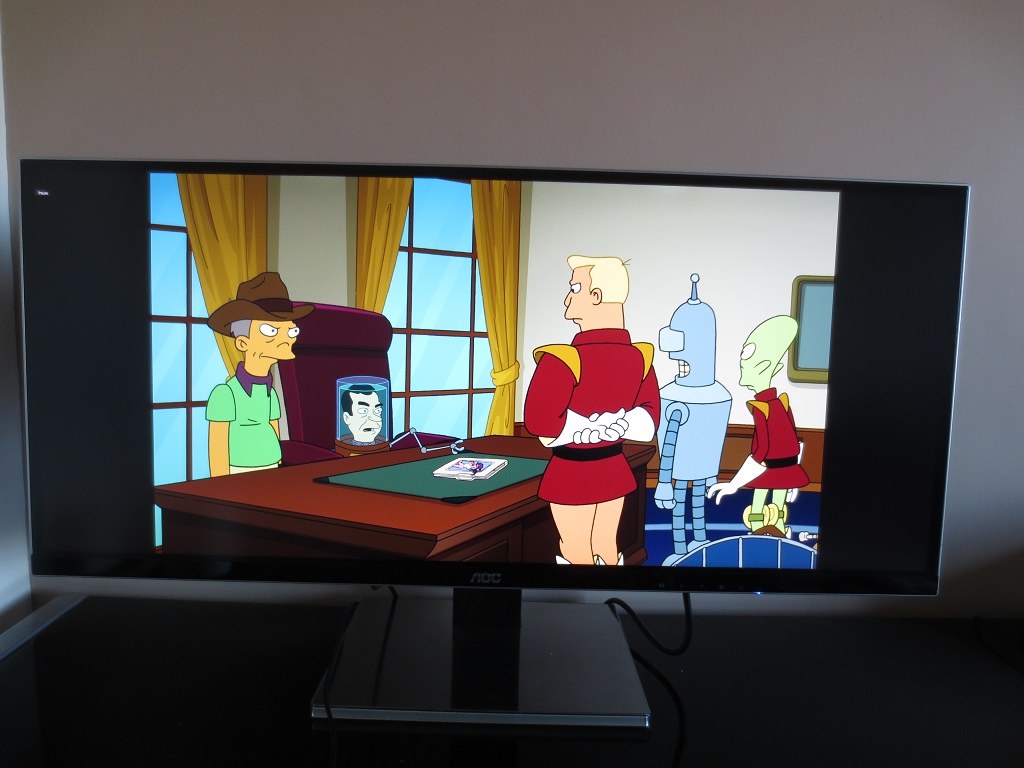

The UltraWide aspect ratios of 2.35:ane – ii.xl are more common on big-budget Hollywood blockbusters. Films that are originally shown in cinemas, as many cinemas now take UltraWide screens. In our commodity that introduces the concept of the 21:9 attribute ratio, we expect at how the handling of such moving picture content varies based on the moving-picture show software that is used. The paradigm below shows the Blu-ray of James Bond: Skyfall on the correctly set up ArcSoft TotalMedia Theater 6 player.
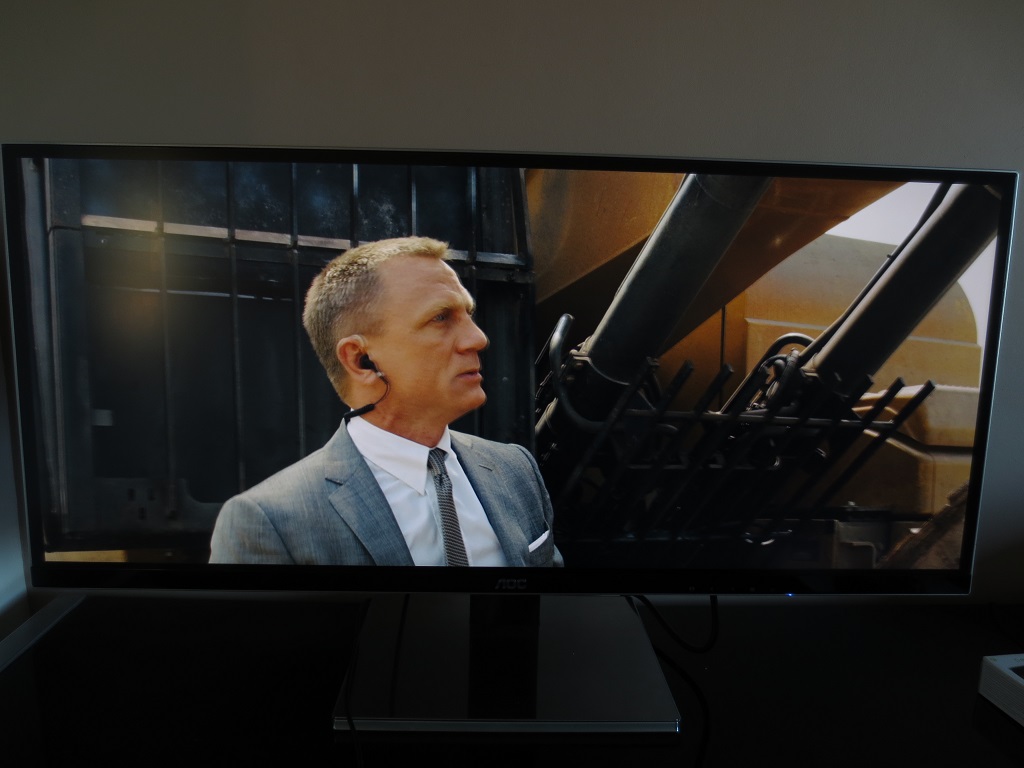
It fills the screen completely without baloney. On a 34" 21:ix screen that gives an incredibly immersive cinematic feel, something yous don't oft make it the comfort of your ain home unless you're heavily into VR headsets and the like. Unfortunately ArcSoft no longer supports TotalMedia Theater, so if you don't ain it and then there is no way to legally obtain a license and activate information technology. We also tried Corel WinDVD Pro 11 and Cyberlink PowerDVD 14 Ultra, merely none provided the undistorted full screen experience that ArcSoft's solution did. This is a quite sad state of diplomacy, really. Plenty of speculation exists every bit to why back up for TotalMedia Theater was dropped and that'south not something we want to add to or assess here. Having said that it is quite articulate that there is a growing trend for digital rather than physical media delivery, not just for PC games but as well movies. We tried a wide range of titles on Netflix and initially constitute that the content was ever centred with a degree of black space around information technology. Even when we ran the u3477Pqu at 1920 ten 1080 to access the 'Image Ratio' settings (including 'Movie1' and 'Movie2') it was not possible to go rid of this black border entirely.
Fortunately streaming media is better supported now than when we showtime wrote this article and it'due south something we keep to assess as nosotros test new UltraWide monitors. Microsoft's Edge browser natively supports 21:9 for appropriate content on Netflix and so does the standalone Netflix app for Windows, giving a screen-filling feel. 16:9 content is presented undistorted, with black borders at the sides. Some content is filmed in an aspect ratio betwixt 16:9 and 21:9 (or thereabouts) and is presented with smaller black borders at the sides. An extension for Chrome and Firefox called 'Ultrawidify' allows you to gain a screen-filling experience whilst keeping the monitor at its native resolution. Like alternatives are likewise bachelor, such as 'Better Netflix'. For content that was originally designed for UltraWide viewing (and in that location is a lot of that on Netflix), this was done without whatever distortion or clear loss of the original definition. The awarding simply 'zooms in' but similar ArcSoft'south TotalMedia Theatre was able to do – shown below for 'The Hobbit: The Desolation of Smaug'. For content that was originally intended for 16:9 viewing (Goggle box shows and the like) the extension automatically detected this and did not 'zoom in' equally this would slightly crop the image – although you lot can manually override this if preferred. The extension too works with YouTube, although the version nosotros tested didn't support automated aspect ratio detection on YouTube then you will have to determine this yourself and manually select the appropriate setting. This manual override may also exist required for Netflix now, due to stricter DRM being employed. Ultrawidify has undergone many upgrades since we tested it and various alternatives are available, being able to watch moving-picture show content or TV shows in a screen-filling mode shouldn't exist as well hard. Alternatives also exist that are specific to Disney+, such as 'Disney Plus UltraWide Fullscreen Support' for Chrome.
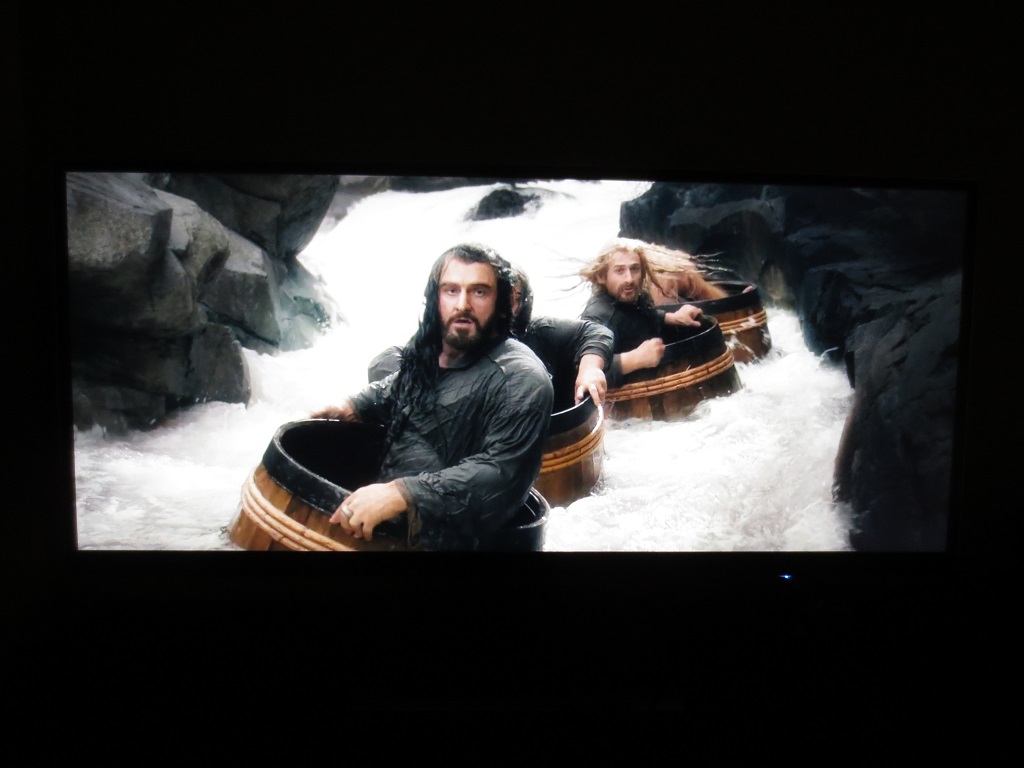
Some other popular way to stream or download moving picture or Television receiver content is Amazon Prime Video. We tested this on Google Chrome and institute that although most films seemed to be presented with black bars at the top and sides, some of the movies filled the 3440 x 1440 screen entirely without geometric baloney. This mainly applied to those mastered in UltraWide aspect ratios – big Hollywood blockbusters for example. This monitor made viewing such content a existent joy (and very engrossing). This finally gave us the kick we needed to catch up on some quite enjoyable movies nosotros never got around to watching at the movie house – The Night Knight Rises, Non-Stop and Mud to name but a few. The epitome below shows 1 of those screen-filling movies, Cuban Fury, streamed on Amazon Prime number Video.
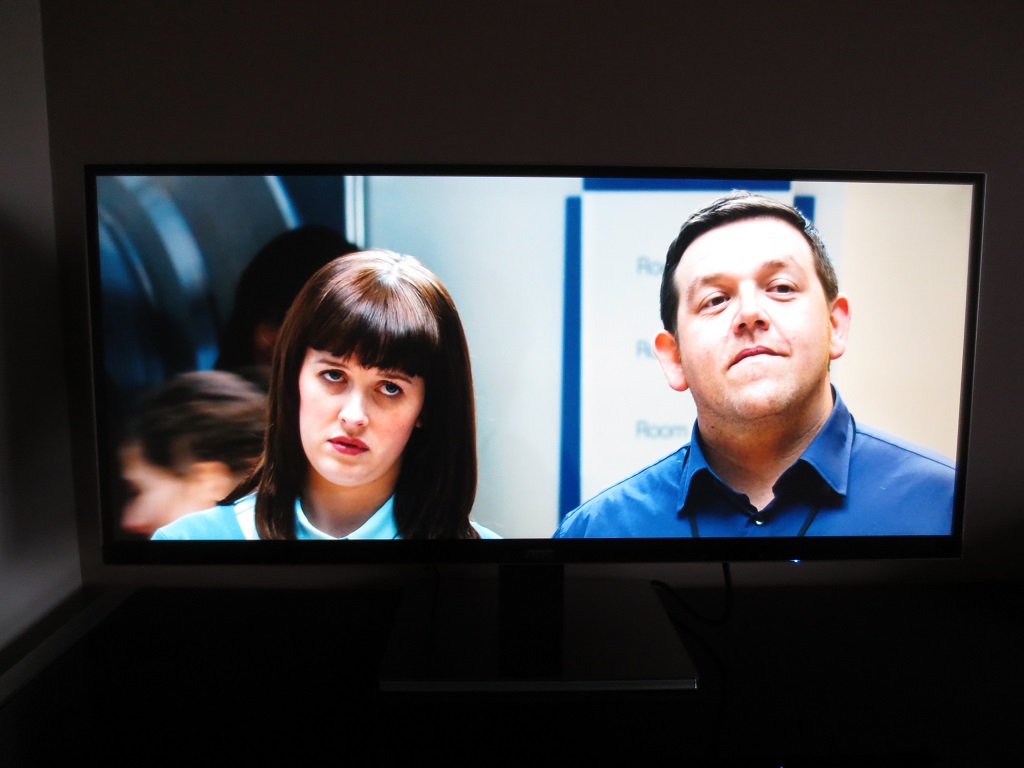
Conclusion
Monitors take get both bigger and higher resolution, with plenty of relatively expensive but desirable options out in that location to tempt consumers. In that location are many different paths that a user can become down when information technology comes to a monitor – nosotros can say with authority that no monitor is perfect. A dilemma which many users now face, if they're after the best definition and color quality from their experience and plenty of desktop space, is whether to become downward the 34" 3440 x 1440 route or the UHD ('4K' or college, 3840 10 2160+) route. With the UHD '4K' or higher resolution options, you gain the reward of a greater number of pixels. You therefore gain more 'real estate' on the desktop and, depending on screen size, greater pixel density and potentially meliorate clarity and detail. The downside is that it takes more GPU power to run these college resolutions. And depending on screen size it is more likely that a user will have to adopt scaling for a comfy viewing feel. That's something that is a bit striking and miss at nowadays but will undoubtedly better in the future.
Some users actually end upwards settling for monitors with the 2560 10 1440 (WQHD) resolution, which is very understandable. That resolution offers a comfy pixel density for many on the common 27" screen size and a decent amount of desktop space. For those who crave higher densities without the need for extra pixels there are too a number of smaller WQHD screens beingness introduced with 23.8" and 25" screens. What the 34" 3440 x 1440 models do is take that comfortable 27" WQHD screen and aggrandize information technology horizontally. The pixel density remains very similar but you gain actress usable space and pixels. This 3440 ten 1440 resolution was ane that nosotros found overnice to use on the desktop. Information technology offered a comfortable pixel density and when combined with the very light matte screen surfaces used on these sorts of monitors a skillful level of clarity.
For games nosotros found support for 21:9 was very widespread, and where there were occasional gaps there were usually people busy out at that place finding solutions (e.thousand. Flawless Widescreen). On the array of games we tested the experience was uncommonly captivating in UltraWide. The Field Of View (FOV) gained over xvi:9 and 'taller' aspect ratios was dandy non just from an immersion bespeak of view but also from a competitive point of view. Now nosotros're non suggesting hardcore gamers who love fast-paced gaming should shun their high refresh rate xvi:9 monitors for one of these, but there is definitely something to be said for the edge that the extra Field Of View provides. And since this article was beginning published, plenty of high refresh rate UltraWide options take been released – so yous can have your cake and swallow it.
These 21:9 models were first introduced to deliver a cinematic feel in movies, mimicking the sort of aspect ratios seen in UltraWide cinemas. It seems somewhat ironic, then, that movies are where back up is seemingly the most mixed. We were very happy to exist able to bask some proper screen-filling content for physical media using TotalMedia Theatre vi. Unfortunately ArcSoft has dropped back up for this software, which at our time of testing was the merely legal Blu-ray software that seemed to support such content correctly. Nosotros were also able to enjoy total screen UltraWide content on Amazon Prime Video. And too on Netflix when using an appropriate browser (Microsoft Border), the app or a browser extension on Chrome or Firefox. Physical media has now fallen out of favour, and so at least it's good to see the aspect ratio ameliorate supported for streaming media. And with this said we enjoyed the movie watching experience overall – especially that screen-filling UltraWide content.
It's important to realise that 21:9 screens are non only a passing fad, they're a technology embraced past many users and strongly supported by monitor manufacturers. Since this article was published, the engineering has expanded to comprehend unlike panel types and higher refresh rates. These UltraWide screens also lend themselves well to being curved, for an extra dose of immersion and potential advantages in other areas including viewing condolement. Nosotros've now reviewed a range of 3440 x 1440 models, including those which are curved and take a high refresh charge per unit. On all of these models, nosotros've enjoyed the experience that the 3440 x 1440 resolution and 21:9 attribute ratio accept provided. It has too expanded onto 38″ screens with a 3840 x 1600 resolution, offer a similar experience to that described in this article only more immersive due to the actress size. Some examples of our experiences with UltraWide screens of varying curvature are linked to beneath, for reference.
Further reading
- The BenQ EW3880R review looks at the scaled up feel with a 37.v″ screen and 3840 ten 1600 resolution.
- Our Dell U3415W and Samsung S34E790C reviews have some thoughts on what a gentle (3000R) curve brings to the table.
- Our ASUS MX34VQ and AOC AG352UCG6 reviews take a look at a steeper (1800R-2000R) curve.
- In our AOC CU34G2X review we share thoughts on an fifty-fifty steeper bend (1500R).
As an Amazon Associate I earn from qualifying purchases fabricated using the below link. Where possible, you'll be redirected to your nearest store. Further information on supporting our work.

Source: https://pcmonitors.info/articles/games-movies-and-the-desktop-at-3440-x-1440/
0 Response to "Is It Hard to Read on a 34inch Ultrawide 1080"
Post a Comment